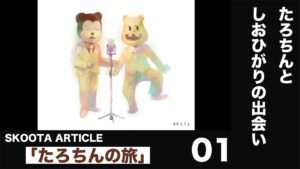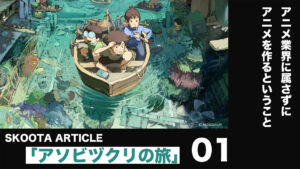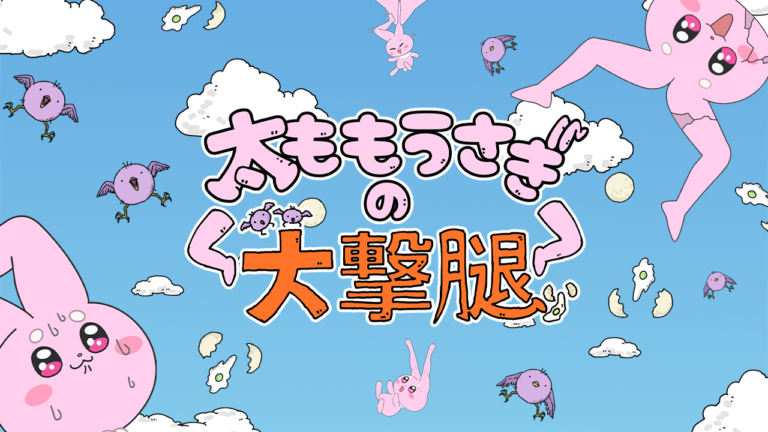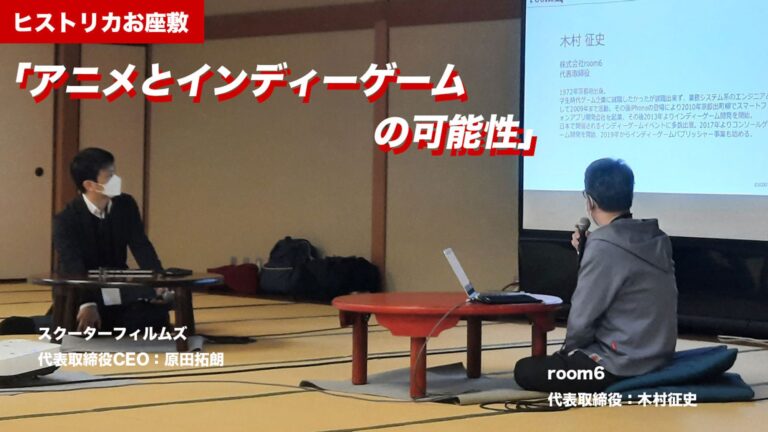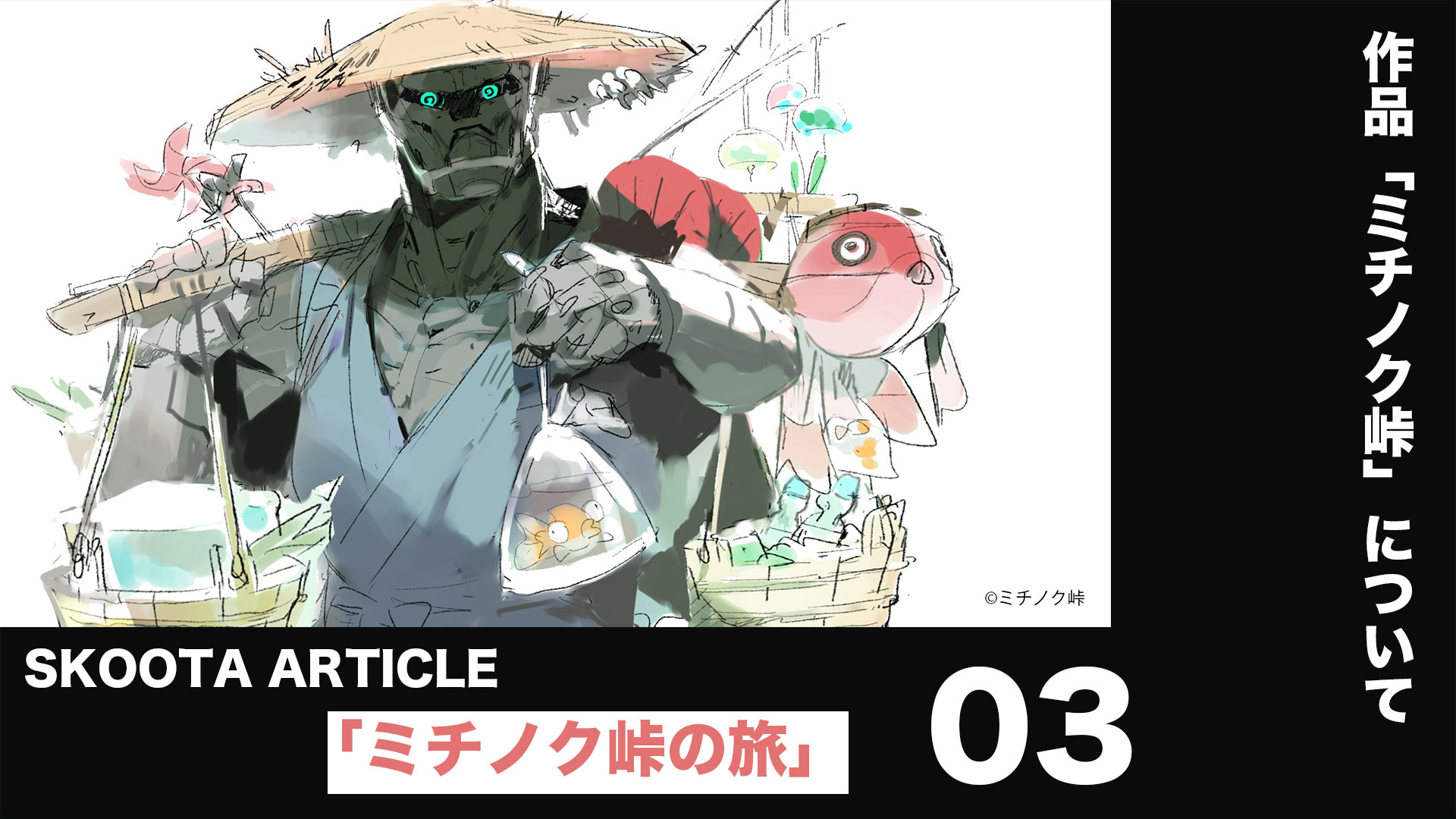
This article can be listened to as a podcast on the following media.
Guest, Personality
Guest, Personality
Guest: Michinoku Toge
Animation Creator / Game Art Designer, mainly engaged in animation production. Currently, I am producing and posting a short anime called “Michinoku Toge”.
Personality: Yuuki Sakoda
After working for a telecommunications company and a comprehensive advertising agency, he started an anime planning and production company and produces music videos and films. In 2021, he moved to Kyoto and started working on promoting the entertainment industry in Kyoto. He is currently also working in the entertainment field of manga and audio. He is planning and producing audio dramas and webtoons. In addition, he serves as a producer and advisor for multiple entertainment companies.
Table of Contents
#01
・From Kazunoko-san to Michinoku Toge-san
・The trigger for aspiring to create animation
・Realizing that the quality of 3DCG is based on 2D animation
・The appeal of Disney Pixar storyboards
・Being Japanese in temperament
・Valuing the atmosphere in cuts during production
・The source of inspiration from Brother Bear
・Wanting to create a Japanese version of Brother Bear
・Wrapping difficult themes in entertainment to make them digestible
・Enjoying depicting living things
・Wanting to create freely and diversely, which led to joining a game company
・People who can do things within the company, things that are advantageous to do, those who prefer freelancing, and what can be done
・The existence of the inner self
・The great failure of the graduation project
#02
・What I learned from my seniors at the company
・Don’t rush, mindfulness, not thinking
・Are there tips for not thinking?
・Putting unpleasant things on the shelf, covering up unpleasant things
・Making things gray
・The inspiring MV of Airy Me
・The routine for generating creative ideas
・Researching thoroughly on the topic
・Making difficult things easier to convey through art and creativity
#03
・Experiencing crowdfunding
・Initially trying to do it all by myself…
・Anime that can’t be done smartly
・Where is the essence of humanity and craftsmanship?
・Through the arrival of AI, it has become clearer what we are seeing and seeking through our works
・The importance of context is becoming more prominent
・About the work “Michinoku Toge”
・Wanting to convey the identity and essence of Tohoku
・What I want to convey in episode 10 of “Michinoku Toge”
・The fact that constraints are predetermined from birth
Starting #03
My Experience with Trying Crowdfunding
Sakoda
Now, let’s delve deeper into Michinoku-san and his current activities. During the recording, we were in the midst of a crowdfunding campaign for a work called “Michinoku Toge”. Therefore, I would like to hear more about this work and the crowdfunding campaign.
I want to realize the animation production of all 10 episodes of “Michinoku Toge”
Michinoku-san became a freelancer after working as a company employee, and chose anime as the output method to convey the themes he wants to express through his own works. Currently, he is undertaking a major challenge of crowdfunding. I think I can somewhat understand his feelings because I have also experienced crowdfunding for an original anime work. I would like to hear Michinoku-san’s current thoughts and feelings about how he started and how he feels now that he has tried it. Could you please share his raw and honest feedback with us?
Michinoku Toge
Well, let me see. There’s quite a difference between the excitement I show on my SNS and the excitement I had when I started my crowdfunding campaign, haha. Anyway, first of all, let me talk about my feelings when I started the crowdfunding campaign…
Sakoda
Oh, wait a minute, Michinoku-san, can I say something important? Um, at the moment of recording on June 15th, actually, it has already been achieved 100%. Congratulations!
Michinoku Toge
Thank you very much. I am very surprised and grateful to receive support from so many people. When I first started, I was wondering what I was doing, but now I am deeply moved to see so many people supporting me.
Sakoda
Congratulations.
Michinoku Toge
Thank you very much. I was initially feeling quite negative. At first, I thought I would try to create something sustainable, using my own strength as much as possible, without relying on crowdfunding and while working my own job.
However, as I focused on producing “Michinoku Toge” and withdrew from paid work, it became increasingly difficult to live. “Michinoku Toge” is available for free on YouTube and there are no sponsors or clients, so no money is generated. I think it is seen as an original animation work, but it only has a number of views that cannot be monetized on YouTube. I also saw other people doing similar things as me, creating their own works, which made me gradually lose my motivation. So my motivation decreased, making it harder to live, and I reached my limit of continuing. That’s why I decided to try crowdfunding as a last resort.
Now I have a completely different perspective, but at first, I felt that crowdfunding was somewhat like asking people for money, so it was not fair and made me feel like I was losing. So I avoided it, but started crowdfunding with those feelings. However, I now think it was a great decision. So, while there are negative aspects to it, I think crowdfunding has a very strong effect as an opportunity to express my enthusiasm for my work and convey it to various people.
Sakoda
Well, even though you might think that not everyone is like that, there is an ego that wants to smartly release a work with a seemingly casual face, if there is a genuine story that can be created. I really want to do that, but especially with anime, it takes a tremendous amount of time, which means involving more people, and therefore, more money, or if you’re doing it alone, it takes a lot of time and there are parts that can’t be smartly managed. The conflicts that arise during the creation process, or the twists and turns that happen within the work, are not visible to consumers or fans, but I think that by showing that passion along the way, some people become fans.
I don’t draw or create anything, but I feel happy that there are people who can support and observe that. However, you don’t know until you try it. But when you do, you understand what it means, and you can create a work that not only smartly presents it, but also shows the struggles, the tremendous happiness, or the great sadness. As a means of conveying the creator’s passion and desire to create, I also think that there is crowdfunding.
Where is the essence of humanity and craftsmanship located?
Sakoda
If we talk about branding in the age of SNS, I personally feel that the process itself becomes a work of art. I wanted to hear Mr. Michinoku’s opinion on this, but after the emergence of generative AI, we now have a world where the final output comes out with incredible rationality and speed. Most people can imagine a future where not only text, but also visuals and images are generated with incredible accuracy. In such a situation, we need to focus on where the “humanity” lies.
Also, when it comes to the question of “what is the essence of creation?”, I think it inevitably becomes a discussion of the process. As humans, we have passion for things and sometimes we don’t even know why we want to do something. I believe this is essential to human creativity. I have been thinking about these ideas, but Mr. Michinoku, do you have any thoughts on this topic?
Michinoku Toge
At first, I felt threatened by AI just based on my intuition, but at the same time, I also had a desire to make my work easier. So, I started researching AI that can generate things, sort of like wanting it to do the work for me. While the AI did produce good results, it became clear to me that something was missing in what the AI was generating. It wasn’t about whether it was understandable or amateurish, but rather, it lacked a human touch. As Mr. Sakoda mentioned earlier, it lacks that human quality. I think people who unconsciously enjoy looking at things from a certain context or background, or maybe something contextual, feel joy when they see something that an author created because they wanted to create it.
So, it seems that creating something that is superior or outstanding is not as important as it once was. Instead, the contextual aspect has become more important. Another way to look at it is through a simple example – let’s say you feel that the leftover cold dinner from last night tastes better than the store-bought food. Clearly, the store-bought food was made using more sophisticated techniques, but you still prefer the leftover dinner. It’s the same when you have something made for you – you feel a joy in that, or maybe it’s unconscious.
At the same time, I think it has become clear what we are looking for in art or in creating a piece of work. There are often talks about how illustrators, for example, will lose their jobs due to AI, but I don’t think that’s true. Ultimately, humans are the ones controlling the generating AI and giving it instructions. It’s just that the hands doing the work have changed to AI. However, there is still a contextual aspect to this, and currently, I think the people using the generating AI are still in the early stages of understanding it, so it hasn’t been evaluated much yet. That’s why I think it might become something like conceptual art. In any case, I don’t think people should be afraid of feeling threatened by AI. Instead, I think AI might become a stepping stone towards creating better conditions and better things.
Sakoda
That’s right. Just like how media and creations change as the tools humans use to create them change, there is simply a process of change, but at the end of the day, humans are the ones who handle and consume them. I think the message is that the creator’s vision and what humans create doesn’t change. Also, what I thought was quite good is that with the emergence of AI, it has become clearer what we are looking for in creating works, or rather, it has become easier to understand. I thought it was a pretty good saying.
Michinoku Toge
Well, yeah, I guess so. It feels like there are some parts I can really relate to. I feel that way when I see the battle between AI and humans unfolding on social media.
Sakoda
Returning to the discussion, I think it’s good to see something like crowdfunding where creators can show their egos or quirks and say, “I don’t really know, but I want to make this.” Doing crowdfunding means showing these things quite vividly, and it can lead to increasing accomplices or supporters. It’s like the discussion about “kotodama” earlier. I also think that words can become both good or bad curses. For example, there are often cases where words said by parents during childhood become stuck in one’s mind like thorns and then dominate them like a curse, which can be either a bad or good curse. If you are told positive words, they can become a curse that affirms your life for a long time, and the opposite may also be true. Anyway, if I forcefully connect this to crowdfunding, when people do crowdfunding, they are positively expressing their desire to create something. So I think this spreads quite a bit, and it can become a small or big step forward, but it will definitely be a steady step forward. In fact, Mr. Michinoku is now saying that he’s glad he tried it, and he’s feeling good about being able to achieve his goal and continue producing and delivering to everyone.
Michinoku Toge
Well, I really think the results were good. There was a time when I wanted to express the struggles and pains of this production without using crowdfunding. For example, I wanted to say, “Actually, it’s been tough,” during my private live on YouTube, or I wanted to say on Twitter, “I just want to live a normal life already.” Well, not so much that I wanted to say it, but I tried hinting at it experimentally. But somehow, it just made people move away from me. If I say things like that, it comes off as complaining, so I’m more concerned about the negative words that are spreading online than anything else.
It’s like, um, it doesn’t leave a good impression, or rather, it has its limits. So in that sense, crowdfunding is a negative word that means it can’t be achieved without power, but for those who see it positively, it has the power to evoke empathy as something meaningful. I think there are things that are difficult to convey through other methods.
Sakoda
Interesting. I thought it was great to hear Michinoku-san’s words in real time, after their perspective changed due to doing a crowdfunding campaign. The latter half of the conversation was about their future vision for the work “Michinoku Pass” and their career as a creator, linked to the crowdfunding campaign. I hope we can hear more about that.
Now, we would like to play a song for you. I believe this is from an artist from Ireland, with the song title spelled out as M-A-N-A-M, which is the same as the artist’s name. Please listen to it first, and we will hear the story behind this song at the beginning of the latter half.
About the work “Michinoku Toge”
Sakoda
Yes. So, regarding this song that you asked about, it was actually discovered by Michinoku-san by chance.
Michinoku Toge
Yes, that’s right. I was looking for some background music while I was working. I was searching for related artists when I came across a YouTube channel of an Irish choir and decided to give it a listen. My impression was that it had a sacred feeling, like religious music. Religious music can be difficult to approach or hard to listen to because it’s not embellished, but this song was dramatic with a professional and raw quality that was exciting to me. I also liked the sacred aspect and was influenced by the piece, so that’s why I chose it.
Sakoda
Well, I want to ask about the respect and interest towards sacred things and such. Now, I would like to delve into the work “Michinoku Toge”, and it seems that there are various motifs and sources that are directly described in the work related to it.
Therefore, I think there are various settings and themes, but first, I would like to know what type of person Michinoku-san is. In other words, is he the type who wants readers to feel it to some extent within the work, or is it okay to talk about it here? What kind of feeling does he have?
Michinoku Toge
Oh, it’s okay to talk here. Actually, if you could feel it in that work, that would be great. But still, there are some parts that cannot be expressed or talked about within that time frame, and also, I think that if you don’t have a certain level of knowledge, you may not be able to understand that this is a quote from that or that this is being based on a motif. So, I still want to talk about it a little bit.
Sakoda
Hmm, I see. In the second half, we’ll delve into that a bit more and try to bring up some discussion about the future. I’d like to ask about the theme that you have in mind. It’s about the journey of transporting corpses, right? Actually, I noticed this again when I looked at the crowdfunding page, but it seems that the aliens who came to this world are being reborn or baptized in some way. I thought, “Oh, I see,” when I read it on the crowdfunding page, but I’d like to know where this theme, and others like it, originated from.
Michinoku Toge
Well, first of all, I wanted to express that I am from Tohoku, and I have noticed that there aren’t many anime or manga that use the pastoral themes or motifs unique to the Tohoku region. It’s a pretty niche genre, and I felt like Tohoku wasn’t getting the attention it deserved, both in my student days and as a working adult. So I thought I’d create something in the medium of animation to express that Tohoku identity or essence, and share it with a wide audience.
Another thing is that I wanted to express the gritty side of Tohoku, but if I just did that, it would be kind of boring, like medieval fantasy or something, and not really relatable to my own world. So I thought about how to make it more appealing, and I realized that by contrasting it with something modern or futuristic, it would make the Tohoku essence stand out even more. For example, if you see a modern building or a sign in the middle of a rural area or a natural tourist spot, it really catches your attention and changes your interpretation of the surrounding nature or town. So I figured if I added some sci-fi or alien elements, it would create that same kind of contrast and make the Tohoku essence even more interesting.
So, the idea is that the alien enters this pastoral, idyllic setting and begins to develop the story. As for a specific strong theme for the storytelling, it was actually added later, but the main goal is to express this pastoral worldview. The reason for carrying a corpse is because it’s a very eerie thing, and eerie things tend to create shadows. Adding a horror element and a sense of awe makes it more interesting and adds depth to the story.
You mentioned on the crowdfunding page that you realized the short length of the video meant you couldn’t do much storytelling, so you had to create images in a somewhat rough way for the viewer. Especially in the first episode, which is designed like a music video and has a rather difficult structure as a story. However, by doing that, you were able to incorporate the images and cuts you wanted, and if viewers can feel a certain Tohoku-like atmosphere through the mood, you consider it a success. So, if viewers can capture that sense of an MV in the first episode, then it passes, and the following episodes are more story-oriented. But during the production of the MV and the first episode, there were some comments about feeling a sense of intimidation that they couldn’t quite understand, so you switched to a concept that is easier for viewers to understand. However, you still lack confidence in the directorial aspects, but you’re trying to minimize the parts that you don’t understand as much as possible while creating it.
Sakoda
Not just in “Michinoku Pass,” but when I watch other videos by Mr. Michinoku on YouTube, I really feel like he wants to depict daily life. Like when he’s eating rice or something, it’s a local culture or a folk motif, and there are scenes of simmering pots. I wondered if that was also a food from Tohoku or something like that.
Michinoku Toge
Ah, exactly, it’s that soup called “kan-tara-jiru”. It’s a bit of a grotesque food where you boil a whole fish in it.
Sakoda
In the scene at “Michinoku Pass” in the story, there’s a part where they talk while huddled around a pot and a scene where snow drips down, and even though there isn’t really any significant development, the relaxed conversation is very Japanese film-like, if that makes sense.
Michinoku Toge
Ah, I see. I am aware.
Sakoda
Yes, that’s right. It feels like there’s this Japanese quality or meaning to being Japanese and a creator in Japan that’s really conscious. And you can really feel the desire to depict the idyllic landscapes of Tohoku. However, if it’s just idyllic, it can become too much of the same thing. So, by adding elements like aliens or shadows of corpses, it creates a sense of tension. It’s like the setting where I might have hidden a corpse somewhere adds a different interpretation to the idyllic rural landscape, almost like a mystery trope.
Michinoku Toge
Well, let me see. I think I personally like creepy stories, so maybe I naturally incorporated them into my interests.
Sakoda
I have an image of Michinoku-san depicting a science fiction world. I can’t remember the title, though.
Michinoku Toge
Oh, is it something like “Alien Pizza” or something like that?
Sakoda
Oh, yes, that’s right!
Sakoda
Somehow, the impression from that side was always stronger. When I first saw it, I thought it was amazing imagery, so it depicted a kind of gadget feeling in SF, like early Akira Toriyama’s, with incredible gimmicks. The mix with that SF feeling is amazing.
Michinoku Toge
Yes, there were intentional parts in the mix. Earlier, “Alien Pizza” was compared to Akira Toriyama’s early work, and yes, “Alien Pizza” was made before the 80s revival boom started. Even though it was before the boom, I thought it would be fresh to make something like the 80s future, so I researched it seriously and put in various elements. So in that sense, I feel like I was able to add depth to the expression of science fiction.
As for the works I referred to, there is of course Akira Toriyama’s art style, but also “Teenage Mutant Ninja Turtles” and such. Also, there is that buttery feeling that is typical of that kind of style, and I think it’s an 80s image. I think from the late 80s to the early 90s, there was a movie called “Lilo & Stitch,” and when you say Stitch, you can’t help but think of that Stitch with all the sparkles from Disneyland, but actually, if you look at the original, it’s drawn with a pretty unique science fiction feeling, not the usual SF feeling with an edge. So, I thought that kind of aspect would match the taste of “Teenage Mutant Ninja Turtles” and Akira Toriyama, so I drew it based on the art and background of “Lilo & Stitch.” In line with that, I also drew the science fiction elements of “Michinoku Pass,” so I feel like I was able to draw science fiction properly.
Sakoda
I’m thinking of summarizing things soon, but I believe that the crowdfunding campaign for the work “Michinoku Pass” started with the goal of making the remaining six episodes, with four episodes already completed. While discussing what we want to convey in these 10 episodes, I also want to hear about the future vision of Michinoku-san and the work “Michinoku Pass” towards the end.
Michinoku Toge
Well, I have the desire to convey my bitter experience from my time as a company employee and have made it into a theme. The theme is that we are born with predetermined constraints. It’s about issues related to bloodlines or, to put it more harshly, educational discrimination, which is a common occurrence. There’s also the caste system. It’s not the full-fledged caste system found in India, but rather a certain caste-like phenomenon. No matter how much effort one puts in, they can’t change their position because of their birth. I’ve faced such situations where I’m stuck being who I am.
Looking at it positively, there are many stories of overcoming such things, but in reality, it’s a significant problem that can’t be ignored. I feel that it’s a harsh reality. I wanted to give shape to that feeling. As for how it all connects, it’s going to be a bit of a spoiler, but there are alien beings with sci-fi elements in the place they originally inhabited, and a caste-like system has developed there. I want to depict the importance of changing the environment to escape the suffering and overcome the caste system. For example, in the case of bullying at school, there may be methods to punish the wrongdoer and solve the problem, but realistically, that may not be enough. Changing the environment is crucial, and I want to bring that aspect to the conclusion. Thematically, it’s a story about caste discrimination and the question of what to do about it, with the answer being that changing the environment is essential.
Sakoda
Um, among the various frameworks for interpreting reality, there is a pretty clear divide between overcoming them and avoiding them. In that sense, I feel that Michinoku’s current conclusion leans towards overcoming through avoidance, and I think that’s really great. In other words, I think his philosophy of leaving things gray is also really important, and that’s because entertainment works tend to be about overcoming obstacles and ending in a clear-cut good triumphs over evil, which is easier to understand. So, if a work is made gray, the aftertaste tends to be bad or rather, it becomes hard to understand, and therefore, it is not well-liked. To be honest.
Michinoku Toge
Well, I would say that the ending is weak as a punchline.
Sakoda
Oh, right, right, right. Hmm, it feels like it ended kind of vaguely, in a grayish way, and everyone’s having a hard time feeling catharsis, so it makes you want to just smack the bad guy, but I think it’s because it’s all consistent with that grayness and avoidance for overcoming it, which is symbolized by Michinoku-san’s idea that I heard today.
Michinoku Toge
Well, I feel that it’s consistent. The theme I’m talking about now is about making things gray, and I think younger people may not fully understand the meaning. I used to be the same way, but if you’re too obsessed with the idea of clarifying black and white, you may end up suffering and breaking down. That’s why I think gray is the best. If you’re young and suffering from overthinking, I recommend trying to be gray once. And I hope you can move forward.
Sakoda
No, it’s deep! Although the response of “deep” is not the deepest (laughs).
Michinoku Toge
No, no, that’s not it. In my opinion, everyone has their own motto or way of thinking, even if it may differ from mine. It’s just that whether or not it gets conveyed by talking about it, and whether or not it appears beautiful to others, there’s always a societal evaluation. I don’t really want to judge someone as being great or not based on that. I think everyone has some sort of philosophy that they’ve thought about.
Sakoda
Finally, if it’s okay to keep it simple, is there a vision for what comes next?
Michinoku Toge
Um, actually, if I were to set a clear goal here, it might end up being more difficult in the long run, so I’ll stick with my usual gray area and just make what I want to make. Therefore, whether it’s self-production or client work, I don’t care about the form, as long as it’s getting closer to what I want to create or what I want to approach, that’s my vision.
Sakoda
As times change in the future, our own values may also change. However, we will need to put ourselves in an environment where we can do what we want to do at that time. Well, I also think that being an individual is suitable in that sense.
Michinoku Toge
If there are other things I want to do that another organization is doing, I may not be a freelancer and may have to look for another job. I really don’t know about that.
Sakoda
Yes, that’s right. We should do things in a way that best fits what we want to do at that time. Whether it’s for an individual, a corporation, or a team, there are different ways to approach it. It’s all about doing what we want to do at that moment. But really, if I were to describe the feeling I have towards Michinoku-san in words, it’s definitely diversity, or maybe something like iridescent. I feel like the Japanese expression fits Michinoku-san better.
Michinoku Toge
Ah, I see.
Sakoda
The ambiguous statements made by politicians can be interpreted in any direction. Japanese is an interesting language, isn’t it?
Michinoku Toge
Oh, that’s really deep.
Sakoda
This is a feature of the Japanese language, isn’t it? So, although Japanese may be said to be a language without responsibility, it’s not a language that excessively imposes on someone. I think it’s a language that assumes ambiguity, and that’s one of its characteristics.
Michinoku Toge
When I hear stories like that, I really feel like Japanese people are a unique ethnicity.
Sakoda
You can feel it, can’t you? Yes, that’s right.

![[Asobizukuri no Tabi #02] The Reason I Decided to Create a Self-produced Anime](https://skoota.jp/media/wp-content/uploads/2024/06/TALK-LOG02-アソビヅクリ-300x169.jpg)
![[Tarochin’s Journey #02] Connecting to the Internet from Dreamcast](https://skoota.jp/media/wp-content/uploads/2024/06/talklogたろちん_02-300x169.jpg)
